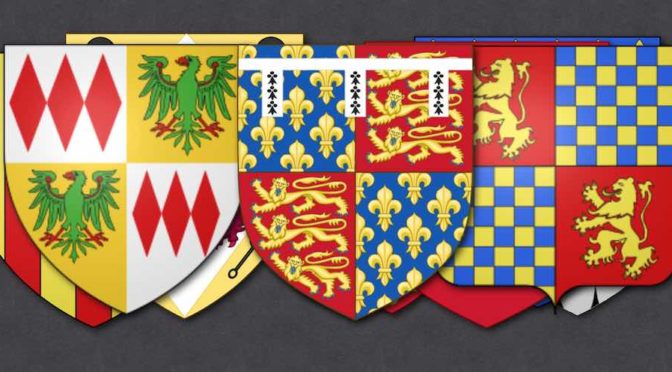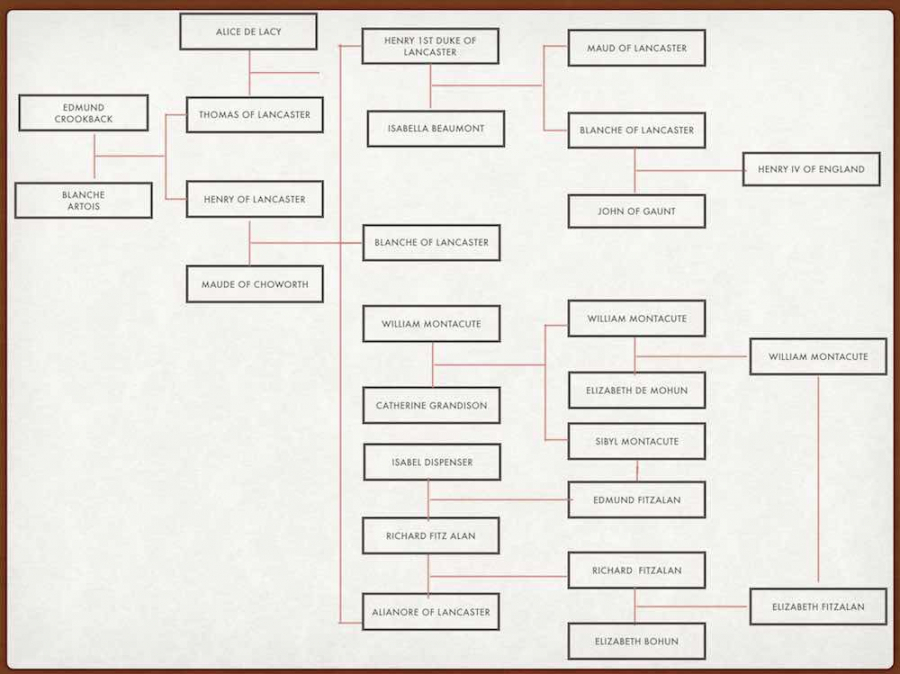Richard Fitzalan married twice:
- Firstly, on 9 February 1321 at Havering-atte-Bower, to Isabel le Despenser (born 1312, living 1356, and may have died circa 1376-7). At that time, the future earl was either eight or fifteen, and his bride nine years old. Later he repudiated this bride, and was granted an annulment by Pope Clement VI in December 1344 on the grounds that he had been underage and unwilling. By this marriage, Richard and Isabel had one son (when Richard was either fourteen or twenty-one, and Isabel fifteen):
- Sir Edmund de Arundel, knt (c. 1327 – 1376–1382), bastardized by the annulment. Edmund was nevertheless knighted, married at the age of twenty, in the summer of 1347, Sybil de Montacute, a younger daughter of William Montacute, 1st Earl of Salisburyand Catherine Grandison, whose elder sister Elizabeth was married to his maternal uncle, of whom it was said he arranged. Edmund protested his bastardization bitterly in 1347, but was apparently ignored. After his father’s death in 1376, Edmund disputed his half-brother Richard’s inheritance of the earldom and associated lands and titles in 1376 and apparently tried to claim the six manors allotted to his deceased mother. He was imprisoned in the Tower of London in 1377, and finally freed through the intervention of two of his brothers-in-law (his wife’s brother John de Montacute and the second husband of Elizabeth de Montacute, Lady Le Despencer). They had three daughters who were his co-heiresses and who brought a failed suit in 1382 against their half-uncle the Earl:
- Elizabeth (or Alice[7]) de Arundel, who married Sir Leonard Carew (1343–1369)[8] of Mohuns Ottery in Devon, feudal lord of Carew Castle in Pembrokeshire and lord of the manor of Moulsford in Berkshire. From Alice are descended all the members of the prominent and widespread Carew family, except Carew of Beddington in Surrey, descended from one of Sir Leonard’s great-uncles. (See Baron Carew, Earl of Totnes, Carew baronets).
- Philippa de Arundel (died 13 September 1399), who married (as his 2nd wife) Sir Richard Sergeaux, Knt, of Colquite, Cornwall. A Victorian historical novel ascribes the following five children to her: a) Richard, born 21 December 1376, and died childless, 24 June 1396; b) Elizabeth, born 1379, wife of Sir William Marny; c) Philippa, born 1381, wife of Robert Passele; d) Alice, born at Kilquyt, 1 September 1384, wife of Guy de Saint Albino; e) Joan, born 1393, died 21 February 1400. “Philippa became a widow, 30 September 1393, and died 13 September 1399.”[9]
- Alice Sergeaux, later Countess of Oxford (c. 1386 – 18 May 1452), who married firstly Guy de St Aubyn of St. Erme, Cornwall, and secondly about 1406–7 (as his 2nd wife) the 11th Earl of Oxford and widower of Alice de Holand (dsp. 1406, niece of Henry IV), and was the mother of two sons by him
- John de Vere, 12th Earl of Oxford
- Robert de Vere, whose grandson, John, became the 15th Earl of Oxford.
- Alice Sergeaux, later Countess of Oxford (c. 1386 – 18 May 1452), who married firstly Guy de St Aubyn of St. Erme, Cornwall, and secondly about 1406–7 (as his 2nd wife) the 11th Earl of Oxford and widower of Alice de Holand (dsp. 1406, niece of Henry IV), and was the mother of two sons by him
- Katherine de Arundel, who married Robert Deincourt.
- Sir Edmund de Arundel, knt (c. 1327 – 1376–1382), bastardized by the annulment. Edmund was nevertheless knighted, married at the age of twenty, in the summer of 1347, Sybil de Montacute, a younger daughter of William Montacute, 1st Earl of Salisburyand Catherine Grandison, whose elder sister Elizabeth was married to his maternal uncle, of whom it was said he arranged. Edmund protested his bastardization bitterly in 1347, but was apparently ignored. After his father’s death in 1376, Edmund disputed his half-brother Richard’s inheritance of the earldom and associated lands and titles in 1376 and apparently tried to claim the six manors allotted to his deceased mother. He was imprisoned in the Tower of London in 1377, and finally freed through the intervention of two of his brothers-in-law (his wife’s brother John de Montacute and the second husband of Elizabeth de Montacute, Lady Le Despencer). They had three daughters who were his co-heiresses and who brought a failed suit in 1382 against their half-uncle the Earl:
- Secondly on 5 April 1345 he married Eleanor of Lancaster, a young widow, the second youngest daughter and sixth child of Henry, 3rd Earl of Lancaster and Maud Chaworth. By Papal dispensation he was allowed to marry his first wife’s first cousin by their common grandmother Isabella de Beauchamp.[a] Eleanor was the widow of John de Beaumont, 2nd Lord Beaumont. The king, Edward III, himself a kinsman of both wives, attended this second marriage. By now, the Earl of Arundel had rebuilt the family wealth and was apparently a major financier of the Crown, and financial sweeteners may have been used to reconcile both the Church and the Crown.[b] By this second marriage 5 February 1345, Richard and Eleanor had 3 sons and 3 surviving daughters:
- Richard FitzAlan, 4th Earl of Arundel, who was his son and heir.
- John FitzAlan, 1st Baron Arundel, 1st Baron Maltravers, who was a Marshall of England, and drowned in 1379. The current Duke of Norfolk descends from Lady Mary, Duchess of Norfolk, a daughter and co-heiress of Henry FitzAlan, 12th Earl of Arundel; being a descendant of John FitzAlan, 1st Baron Arundel.
- Thomas Arundel, who became Archbishop of Canterbury
- Lady Joan FitzAlan (1348 – 7 April 1419) who married Humphrey de Bohun, 7th Earl of Hereford. They were the maternal grandparents of Henry V of England through their daughter Mary de Bohun.
- Lady Alice FitzAlan (1350 – 17 March 1416), who married Thomas Holland, 2nd Earl of Kent, matrilinear brother of King Richard II. They were ancestors to Queen consorts Anne Neville (wife of King Richard III), Elizabeth of York (wife of King Henry VII), and Catherine Parr (wife of King Henry VIII).
- Lady Eleanor Fitzalan (1356 – before 1366).
Possible illegitimate offspring include:
- Ranulph FitzAlan, born c. 1359, who married a lady named Juliana, last name unknown. Through them descended the Hungerfords, the St.Johns, and the Villiers including Barbara (formerly Palmer) Villiers the first of many mistresses of King Charles II.
Richard died on 24 January 1376 at Arundel Castle, aged either 70 or 63, and was buried in Lewes Priory. He wrote his will on 5 December 1375. In his will, he mentioned his three surviving sons by his second wife, his two surviving daughters Joan, Dowager Countess of Hereford and Alice, Countess of Kent, his grandchildren by his second son John, etc., but left out his bastardized eldest son Edmund. In his will Richard asked his heirs to be responsible for building the FitzAlan Chapel at Arundel Castle, which was duly erected by his successor. The memorial effigies depicting Richard FitzAlan and his second wife Eleanor of Lancaster in Chichester Cathedral are the subject of the poem “An Arundel Tomb” by Philip Larkin.
FitzAlan died an incredibly wealthy man, despite his various loans to Edward III, leaving £60,000 in cash. He had been as astute in business, as he had in diplomatic politics. He was a cautious man, and wisely saved his estate for future generations.

